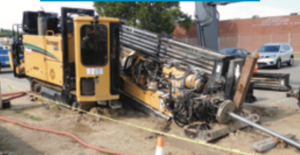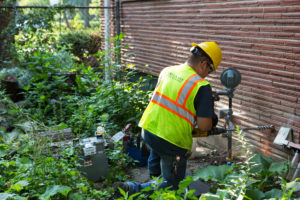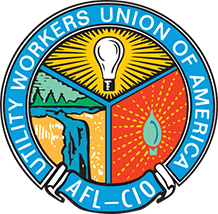On January 1, California will take another major step to reduce methane leaks from storage facilities and pipelines. That’s the day legislation, SB 887, becomes state law.

UWUA Local 483, with the support of sister Locals 132 and 522, was instrumental in drafting and passing the law that will create good paying jobs for utility workers, help ensure public safety, and protect the environment from the harmful effects of methane.
Improving safety and service
SB 887 builds on other UWUA-sponsored California legislation that puts utility workers at the table as equals with employers and regulators on gas safety issues.
The UWUA represents 4,500 workers at Southern California Gas (SoCal Gas), the nation’s largest gas distribution utility. Local 483 represents all SoCal Gas transmission and storage operation employees, including those who operate and maintain the gas storage field at Aliso Canyon, among several others. As the largest natural gas supply reservoir in California, this storage facility helps ensure millions of people have enough energy for their homes and businesses.
During the utility’s last two rate cases, Local 483 President Robin Downs led efforts to convince the California Public Utilities Commission to increase SoCal Gas spending to improve safety and preserve existing service levels.
“Instead of fighting with the company over the money they wanted,” Downs explains, “it made more sense to partner with them because we know that if they don’t get what they are asking for, the cuts are going to be in people, the cuts are going to be in jobs. And, when we looked at the testimony of the company’s storage, transmission and pipeline directors, it was quite clear they didn’t ask for enough money.”
Then, when the Aliso Canyon gas leak happened, Downs partnered with the other UWUA locals in the state and the BlueGreen Alliance (BGA), to educate the governor’s office, state senators and assemblymen about the need for gas storage facilities and the importance of investing in the gas infrastructure.
“We explained how gas storage works and how it can be done safely,” he says.
The end result was passage of SB 887. “The biggest thing in the bill is that it requires the company to work with the union to train employees. That’s the law,” Downs explains.
According to the SB 887, “If storage field employees are represented by a labor union, the operator shall consult with the relevant union local on safety issues and, when requested, establish a framework to provide training through a joint labor-management training program.”
Mentoring younger workers
SB 887 requires companies to hire workers with years of experience to mentor younger workers. This ensures the knowledge gained over years of work experience is passed on. All told, the legislation will result in the addition of 25 – 30 new members to Local 483, with the potential over time to add more.
Working with the local, SoCal Gas created seven new positions in transmission and storage, including three senior specialists who will be mentors for their union brothers and sisters. In addition, for the first time, two electrician positions were created.
“The number one thing that I’ve learned in this whole process,” says Local 483 Vice President Paul Carriera, “is you can argue and plead with the company all you want, but when you get involved with the passage of laws, that’s when you’re going to see true change.”
Investment in Gas Storage Critical
The country’s need for infrastructure investment has become a national rallying cry for rebuilding the American middle class by rebuilding the physical structures that make a strong economy function. Maintaining, repairing, and replacing natural gas transmission, distribution, and storage systems presents a key opportunity for ensuring the health and safety of utility workers and their communities, creating and protecting utility sector jobs, and all while helping to ensure a clean environment.
When the system receives a major shock, such as the Aliso Canyon leak in California, the UWUA has been at the forefront, speaking out on the need for investment in facilities, proper maintenance, staffing, and training.

Michigan is investing in it’s gas inftructure. Pictured here is a directional bore machine used to lay new gas lines as part of Consumers Energy’s Enhanced Infrastructure Replacement Program.
Gas storage reservoirs provide reliable, base-load energy to consumers regardless of whether the sun is shining, or the wind blowing. Even as other energy sources, such as renewable power, continue to come on-line, a majority of southern California’s electricity still comes from natural gas-fired power plants. Storage reservoirs like Aliso Canyon directly supply those plants with gas, and a breakdown in that storage infrastructure can mean power shortages and electricity blackouts.
Supporters of infrastructure investment thus face a common problem in that structures which are indispensable to the functioning of modern society are often invisible, taken for granted, and only noticed when they stop working. Having safely provided reliable gas supplies to the major metropolitan areas in southern California for over 40 years, the vast majority of people who had long benefited from quiet workhorses like Aliso Canyon had likely never heard of it before a major leak was discovered there in 2015.
Utility Workers predicted trouble
In 2014, a year prior to the Aliso Canyon leak, Local 483’s President Downs and Area Officer Paul Carriera testified before the California Public Utilities Commission in favor of increased spending by SoCal Gas in order to operate safely and preserve existing service levels for consumers. They also advocated for the creation of new safety officer positions to mentor the workforce and promote safety consciousness and safety culture.
A number of recommendations for increased safety at transmission and storage facilities were made, foretelling issues that were later to arise at Aliso Canyon. Continuous, in-person inspection of facilities, for example, is necessary to check for safety issues, including indications of leaks due to faulty equipment, geologic disturbances or pipeline damage. Timely repair of leaks, once discovered, is also necessary to prevent their rapid expansion due to changes in operating pressure over time, or due to ground movement in seismically active areas such as California.
Throughout the recommendations, a common theme was the need for adequate numbers of well-trained, empowered employees. Given the large areas over which gas infrastructure is built, and the size and complexity of such systems, understaffing can lead to insufficient or infrequent inspections, and delayed repairs.
In addition to investments in personnel and training, the need for investment in physical infrastructure was noted given that many gas facilities in southern California were aging and
in need of significant replacement or upgrade, with some of the technology dating from the 1950s. Many of the valves being replaced showed evidence of corrosion and received inspection and lubrication only once a year and, in the storage fields, pipes and valves needed even more inspection and maintenance as internal corrosion effects were elevated even higher than in transmission lines.
Fighting for safe storage

In the aftermath of the Aliso Canyon crisis, the UWUA supported efforts to ensure proper investment in gas storage facilities, and improved requirements for their safe operation. Despite urging by the gas company to oppose legislation on improved safety at natural gas storage facilities, UWUA Locals 132, 483, and 522, along with our allies at the BlueGreen Alliance, took to the California State Legislature to advocate for Senate Bill 887, a bill creating proactive safety standards for natural gas reservoirs.
Led once again by Downs and Carriera as subject matter experts, these advocates created a technical paper on how to operate Aliso Canyon safely, laying out their views to state elected officials. Recognizing the expertise of these UWUA members, California Governor Jerry Brown accepted all of their recommendations, including requirements to increase safety monitoring, facility maintenance, and creating a labor/management training program.
Approved by an overwhelming bipartisan majority in both houses of the California legislature (36-2 in the state senate, and 75-1 in the state assembly), SB 887 was signed into law by Governor Brown in September. Without the UWUA’s support, this safety legislation could easily have fallen victim to corporate lobbyists advocating against requirements to change their practices, to force them to spend money on safety, or to ensure the presence of sufficient numbers of properly trained employees.
The jobs and safety solution
Originally sponsored by California State Senator Fran Pavley, SB 887 has now put into place a number of new requirements to ensure the safety of gas storage facilities. Among these are the continuous monitoring of natural gas concentrations, requirements for redundant safety mechanisms such as subsurface safety valves, and new equipment requirements when injecting and extracting gas. Further, full testing regimens must be undertaken on a regular basis, and risk management plans must be developed for gas storage facilities that include prepositioning leak response equipment and creating a process for notifying potentially impacted communities of a leak within 48 hours. As to health factors, the California Public Utilities Commission is also required to undertake an assessment of the potential human health impacts associated with a large gas leak.
On the collective bargaining front, Local 483 worked with SoCal Gas to create a number of new job positions focused on safety for transmission and storage facilities. These include senior gas storage, maintenance, and operation specialists, new electrician positions, and new inventory and administration positions. At a minimum, the local anticipates that these new positions will result in up to 30 new members in the local, with the potential for more over time. The addition of these workers will help to build a safety culture within the gas industry that is absolutely essential to ensuring gas storage facilities are operated safely, and continue to provide reliable energy to consumers for many years.
Ensuring a clean environment
While the U.S. oil and gas industry is a large source of methane emissions, with global climate implications, much of these emissions come simply from leaks in the physical infrastructure. Though accidents do happen, outdated practices and aging technology play an outsized role in creating leaks. These reasons, however, are within our ability to control as practices and technology can be updated and improved, hiring and training can bring more human resources to the issue, and financial investment in facilities can go a long way toward mitigating emissions.
In addition, gas leaks emit benzene, a known carcinogen, which can endanger workers and communities around large leaks. Stopping leaks and, even more importantly, preventing them before they happen, ensures a cleaner, healthier environment both for the planet as a whole, and for those living in immediate proximity to gas facilities.
Natural gas systems, including large-scale storage facilities such as that at Aliso Canyon, will continue to play a vital role in delivering energy to Americans for many decades to come. By working to ensure that safety is directly written into the law and, thus, directly into the workplace, the UWUA has led the way in fighting for utility worker safety and jobs, facility reliability, and clean, affordable energy for consumers—values that the Union continues to advance in California and around the country every day.

